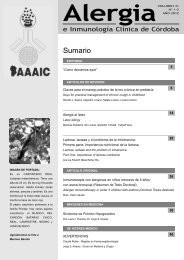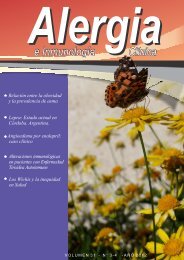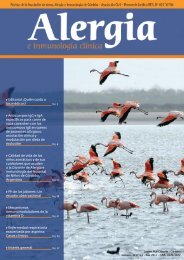Alergia 3-4 2010.qxd - cordobalergia.com
Alergia 3-4 2010.qxd - cordobalergia.com
Alergia 3-4 2010.qxd - cordobalergia.com
Create successful ePaper yourself
Turn your PDF publications into a flip-book with our unique Google optimized e-Paper software.
ARTÍCULO REVISION<br />
ALERGIA e INMUNOLOGÍA CLÍNICA<br />
UN ALGORRITMO PROPUESTO PARA EL MANEJO DEL CUADRO AGUDO:<br />
Chequear y asegurar la vía aérea Buena respuesta, alta con H1 antihistamínicos y<br />
Chequear función hemodinámica glucocorticoides para sostenerla. Prevención<br />
Adrenalina IM y repetir si es necesario<br />
No buena respuesta Buena respuesta, observar mayor tiempo y alta<br />
Elevar miembros inferiores, intubar y administrar con H1 antihistamínicos y glucocorticoides<br />
O2 / Salbutamol. Prevención<br />
Canalizar y administrar fluidos EV<br />
Considerar infusión de adrenalina<br />
No buena respuesta Buena respuesta, sala general con H1 y H2<br />
UTI antihistamínicos, Glucocorticoides.<br />
H1 y H2 antihistamínicos Prevención<br />
Considerar Dopamina, Glucagon, Atropina, Glucocorticoides<br />
Paro cardíaco, Adrenalina en infusión o Respuesta deseable, sala general, H1 y H2<br />
intracardíaca, masaje, desfibrilación, asistencia antihistamínicos, glucocorticoides.<br />
ventilatoria mecánica. Prevención.<br />
Lo indeseable pero, lamentablemente posible, Baja.<br />
Bibliografía<br />
1. Ring J. History of anaphylaxis.Allergy<br />
and clinical immunology international,<br />
2003, 15 (4): 144-148<br />
2. Coombs R. Gell P. Classification of<br />
alleygic reactions responsible for clinical<br />
hypersensitivity and disease. In: Gell<br />
Coombs editors. Clinical Aspect of<br />
immunology. Philadelphia; Davis,<br />
1968, 575-596.<br />
3. Hamilton R. Science behind the<br />
discovery of IgE. J Allergy<br />
ClinImmunol 2005; 115 (3): 648-652<br />
4. Lieberman P, Kaliner M, Lockey R,<br />
Simons F. Allergy archives: pioneers<br />
EVALUACIÓN DE LA SEVERIDAD SEGÚN SÍNTOMAS<br />
Grado Piel Respiratorio Cardiovascular Digestivo<br />
I Prurito,eritema, urticaria,<br />
angioedema.<br />
II Lo mismo pero pueden faltar Estornudos, rinorrea, disnea Taquicardia, arritmias Nauseas, cólicos<br />
III Lo mismo pero pueden faltar Edema glótico, disnea, cianosis Lo mismo mas hipotensión Vómitos, Diarreas<br />
IV Lo mismo pero pueden faltar Paro respiratorio Paro cardíaco<br />
Los grados I y II, permitirían evitar el uso de adrenalina, espectar con H1 antihistamíni-cos y glucocorticoides, con la adrenalina lista si<br />
aparecen signos de progresión al grado III.<br />
and milestones-anaphylaxis and<br />
American Academy of Allergy,<br />
Asthma, and Immunology. J Allergy<br />
ClinImmunol 2006; 117 (2): 478-482.<br />
5. Simons F. Anaphylaxis.J Allergy<br />
ClinImmunol 2008; 121, 2, S402-407.<br />
6. National Institute of Allergy and<br />
Infectious Disease, Food Allergy and<br />
Anaphylaxis Network. J Allergy<br />
ClinImmunol 2005; 115 (3), 584-589 -<br />
2006; 117 (2), 391-397.<br />
7. Mendez J. Del Rayo M.Aponte J.<br />
Choque Anafilactico y Reacciones<br />
Anafilactoides, en <strong>Alergia</strong>,<br />
56 Anafilaxia, una visión practica actual acerca de sus mecanismos y manejo clínico<br />
Enfermedad Multisistémica. Ed.<br />
Panamericana, 2008, Cap 40, 431-438.<br />
8. Brown S. Mullins R. Gold M.<br />
Anaphylaxis: diagnosis and management.<br />
Med J Aust 2006; 185 (5), 283-289.<br />
9. Tang A.A practical guide to anaphylaxis.<br />
J Am FamPhysc 2003; 68, 1325-1332.<br />
10. Copioli J. Barrera R. Cavallo M.<br />
Imwinkelried M. Ponderando el riesgo<br />
de anafilaxia en inmunoterapia con<br />
alérgenos. Archivos de <strong>Alergia</strong> e<br />
Inmunología Clínica 2009; 40 (3), 83-90.






